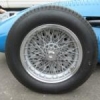There is much debate over the introduction of 18" wheels for F1 cars. Many bemoan and question the change from the 13" wheel that has been used for so long. Yet we in TNF know that it was never the case that larger sized wheels were not used. The Maserati 250F used 16" or 17" wheels as did most of the other cars in the 1950s.
13" wheels seem to have been the size of choice from the 1960s onwards (with the honourable exception of the Tyrrell P34 and its many 10" wheels) and at some point, it became a regulation. I think that was well before the single or spec tyre came in which of course locked in the wheel size whether teams liked it or not.
So what was the progress on wheel size? Going back to the earliest days, wheels were much larger, being based on horse drawn technology. They gradually shrunk but remained larger until the 1960s when both race and road cars seemed to favour the 13" size. Since then, the introduction of low-profile road tyres has driven an increase in size to anything up to 20" or more, and a simlar process followed in racing, except good old F1 - the technological pinnacle supposedly - which stubbornly stuck to an increasingly outmoded small wheel, high-profile tyre combination.
Can anyone cast any light on this matter? What were the drivers for the changes?

























